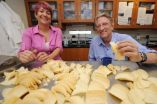A recent Nature Neuroscience study led by Dr. Timothy Ryan, professor of biochemistry at Weill Cornell Medical College, demonstrates that individual neurons somehow control the speed by which they recycle synaptic vesicles that store neurotransmitters before they are released. No one had expected that neurons would have such a powerful "gas pedal," says Dr. Ryan.
Dr. Ryan is also contributing author of a second, Yale University–led study published today in the online edition of Neuron. It shows that the common understanding about how proteins help form these key storage vesicles is flawed.
The two findings help refine science's understanding of the biomechanics that control neurotransmission at the synaptic gap between brain neurons, Dr. Ryan says.
"We are looking under the hood of these machines for the first time," he says. "Many neurological diseases such as Alzheimer's disease, Parkinson's disease, schizophrenia and other neurodegenerative and psychiatric disorders are considered to be synaptopathies -- pathologies of synaptic function. So repairing them will require that we understand how they work."
Both studies focus on synaptic vesicles, which are bubble-like structures that store neurotransmitters within a bi-layer of fatty membranes at the synaptic junction.
Scientists know that in order to deliver neurotransmitter messages between cells, the synaptic vesicle merges with the surface of the brain cell at the synapse and releases the message. Then these synaptic vesicles, which are in limited supply, must be retrieved, rebuilt and refilled with neurotransmitters, Dr. Ryan says. "Failure to do so would result in the synapse running out of vesicles rather quickly, and proper neurotransmitter function depends on their continuous availability."
Measuring Neuronal Speed
The Nature Neuroscience study was designed to look at what controlled the speed of the vesicle recovery process. This speed, which dictates the availability of vesicles, has long been considered to be one of the limits as to how fast neurons can continuously communicate, especially in high-demand situations, Dr. Ryan says.
To study the speed of this recovery process, senior author Dr. Ryan and first author Moritz Armbruster, a Rockefeller University graduate student who worked in Dr. Ryan's laboratory, used a tool that took optical recordings of the speed of vesicle recycling across 84 different neurons.
They discovered something quite unexpected -- an individual neuron retrieves all of its synaptic vesicles at pretty much the same speed. "It is as if the neuron is following orders from a cell-wide central gas pedal," Dr. Ryan says. They also found that while each cell had its own speed at recovering the vesicles, that rate varied four-fold across the different neurons -- even if the neurons were performing identical functions, such as secreting the same neurotransmitter.
"When we compared different neurons, we found that each cell is telling its synapses to go at its own speed," he says. "The mystery that remains is the nature of this gas pedal, and if it might be important in therapeutic approaches to tackling synaptopathies."
Debunking the Dynamin Theory of Synaptic Recovery
The Neuron study looked at proteins involved in one phase of the recovery process, the separating and pinching off of the membrane of the synaptic vesicle from the membrane of the neuronal cell. It was led by Dr. Pietro De Camilli, a professor of cell biology and neurobiology at Yale University and a Howard Hughes Medical Institute investigator, and his colleague Dr. Shawn Ferguson, currently an assistant professor of cell biology also at Yale.
Based on studies in the 1980s, researchers had believed that a protein called dynamin, which comes in three forms (1, 2 and 3), was critical to this "membrane fission" step in the formation of vesicles.
In 2007, the Yale researchers tested whether dynamin 1, which represents 90 percent of all dynamin in the brain, was, as believed, the key protein involved in synaptic vesicle membrane fission. They generated a mouse that lacked the protein but found it produced only subtle differences in the fission process. This surprising discovery was published in Science.
In the new study, the research team, which included Drs. Ryan, Mr. Armbruster and others, looked at what happened when both dynamin 1 and dynamin 3, which makes up 99 percent of dynamin protein, are missing. They used the same optical methods employed in the Nature Neuroscience study to examine the speed of the synaptic vesicle retrieval process.
"Our studies showed that retrieval is now severely impaired when you have neither dynamin 1 nor dynamin 3, which shows us that dynamin 3 has a major presynaptic function," Dr. Ryan says. "Remarkably, however, the retrieval process still happens, and it is unknown whether that could be due to dynamin 2, because that protein accounts for only a tiny percentage of dynamin protein in the brain. It makes sense that there is another protein or biomechanical process that is contributing."
Dynamin is a protein known to play a critical role in synaptic vesicle retrieval. The observation that synaptic transmission can still occur, albeit in a much-impaired way, in the absence of the overwhelming majority of dynamin reveals a remarkable and unexpected plasticity of nerve terminals, says Dr. De Camilli.
INFORMATION:
The Nature Neuroscience study was funded by grants from the National Institutes of Health and the David Rockefeller Graduate Study of the Rockefeller University.
The Neuron study was supported in part by the G. Harold and Leila Y. Mathers Charitable Foundation, National Institutes of Health grants, and the W.M. Keck Foundation. Co-authors are, from Yale University School of Medicine: Andrea Raimondi, Shawn M. Ferguson, Xuelin Lou, Summer Paradise, Silvia Giovedi, Mirko Messa, Nao Kono, Junko Takasaki and Valentina Cappello; and Eileen O'Toole from the University of Colorado at Boulder.
Weill Cornell Medical College
Weill Cornell Medical College, Cornell University's medical school located in New York City, is committed to excellence in research, teaching, patient care and the advancement of the art and science of medicine, locally, nationally and globally. Physicians and scientists of Weill Cornell Medical College are engaged in cutting-edge research from bench to bedside, aimed at unlocking mysteries of the human body in health and sickness and toward developing new treatments and prevention strategies. In its commitment to global health and education, Weill Cornell has a strong presence in places such as Qatar, Tanzania, Haiti, Brazil, Austria and Turkey. Through the historic Weill Cornell Medical College in Qatar, the Medical College is the first in the U.S. to offer its M.D. degree overseas. Weill Cornell is the birthplace of many medical advances -- including the development of the Pap test for cervical cancer, the synthesis of penicillin, the first successful embryo-biopsy pregnancy and birth in the U.S., the first clinical trial of gene therapy for Parkinson's disease, and most recently, the world's first successful use of deep brain stimulation to treat a minimally conscious brain-injured patient. Weill Cornell Medical College is affiliated with NewYork-Presbyterian Hospital, where its faculty provides comprehensive patient care at NewYork-Presbyterian Hospital/Weill Cornell Medical Center. The Medical College is also affiliated with the Methodist Hospital in Houston. For more information, visit weill.cornell.edu.
END

